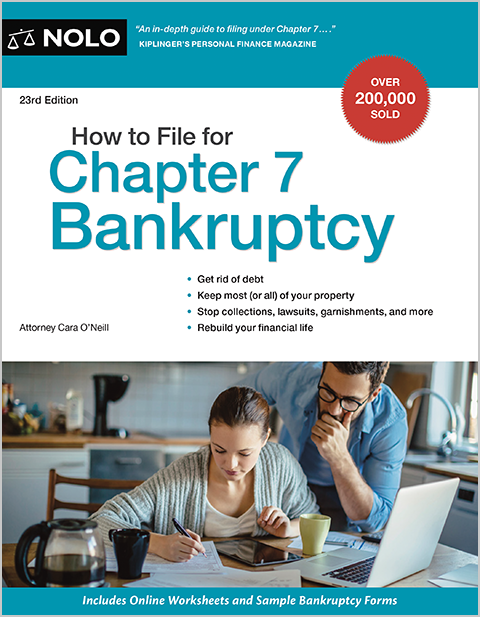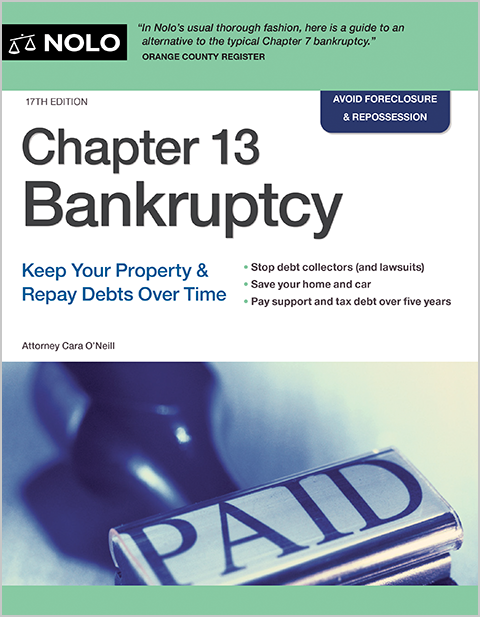The automatic stay in bankruptcy temporarily stops a pending foreclosure.
Many debtors turn to bankruptcy when facing foreclosure, and with good reason. Filing for bankruptcy allows a debtor to take advantage of protection known as the automatic stay. The stay works by stopping creditors' attempts to collect debts or enforce liens during the bankruptcy case.
If you're facing foreclosure and wondering if bankruptcy can help, you'll want to learn the following how bankruptcy's automatic stay works to stop foreclosure, when the automatic stay won't be available to a filer, and what will happen if the lender successfully asks the court to lift the automatic stay.
You'll also learn whether bankruptcy will stop the foreclosure process temporarily or permanently and why the stay's duration depends on whether you previously filed for Chapter 7 or Chapter 13.
- Can Bankruptcy Stop Foreclosure?
- Can Chapter 7 Bankruptcy Stop Foreclosure?
- Can Chapter 13 Bankruptcy Stop Foreclosure?
- Will Bankruptcy's Automatic Stay Stop Judicial and Nonjudicial Foreclosures?
- How Many Times Can You File for Bankruptcy to Stop Foreclosure?
- Can a Lender Ask the Bankruptcy Court to Remove the Automatic Stay?
- Need More Bankruptcy Help?
Can Bankruptcy Stop Foreclosure?
Yes. One of the most valuable benefits of filing for bankruptcy is the bankruptcy court immediately requires most creditors to stop all collection actions, including foreclosure. The foreclosure must come to a halt when you file your paperwork. You'll learn more about why this occurs in the "Will the Automatic Stay in Bankruptcy Stop Foreclosure?" section below.
How Does the Foreclosure Process Work?
When you buy a home, you agree that the lender can take specific actions if you fall behind on your monthly payment or "default on the loan." The lender can sell the house at auction and apply the proceeds to your loan balance in a process known as foreclosure.
However, the lender must follow foreclosure laws before selling your home. For instance, state and federal foreclosure laws often require a waiting period so the homeowner can catch up on arrearages or apply for a loss mitigation program.
Will the Automatic Stay in Bankruptcy Stop Foreclosure?
In most instances, the automatic stay will stop the foreclosure as soon as you file for bankruptcy. But whether bankruptcy will be a temporary or permanent fix will depend on whether you file under Chapter 7 or 13.
Can Chapter 7 Bankruptcy Stop Foreclosure?
Yes, but it's more accurate to say that Chapter 7 bankruptcy delays foreclosure rather than stops it. Chapter 7 buys you time but doesn't help you fix the foreclosure problem because Chapter 7 doesn't offer a payment plan you can use to catch up on your mortgage and keep your house.
If you're behind and want to stay in your home, Chapter 13 bankruptcy is more likely to help you remain in your home. Learn how to keep a house when filing for bankruptcy.
Can Chapter 7 Bankruptcy Help Keep a House From Foreclosure?
It's rare. Some people hope the lender will renegotiate their mortgage and stop foreclosing if they file for Chapter 7. Although entering into a loan workout with the lender is possible, you shouldn't expect the lender to agree to work with you. The lender isn't under an obligation to restructure your loan and allow you to continue living in the house. And many refuse to speak with people after a Chapter 7 filing.
If you want to use bankruptcy to save your home, consider filing for Chapter 13 bankruptcy. The Chapter 13 repayment plan can be used to catch up on mortgage arrearages so you can stay in the home.
Other Ways You Can Benefit From Chapter 7 When in Foreclosure
Because Chapter 7 rarely fixes delinquent mortgage problems, most people use Chapter 7 to buy additional time to arrange other housing. They understand that when Chapter 7 ends, the automatic stay will go away, and the lender will be free to continue foreclosing on the home.
You should also know that in some cases, the automatic stay doesn't remain in place for the entire Chapter 7 case. The bankruptcy court will often lift the stay if the lender files a motion asking the court to allow the lender to resume foreclosure. You'll find more about this in the "Can the Lender Ask to Remove the Automatic Stay" section below.
However, if Chapter 7 bankruptcy is your only option, it's possible to benefit in other ways.
- Suppose the Chapter 7 trustee assigned to your case sells your home. If your home had equity, you'd receive cash equal to the state or federal homestead exemption, possibly more if the equity were enough to pay your debt entirely.
- Also, the trustee would first pay priority debts you'd be responsible for after bankruptcy, such as taxes and support obligations. The funds from your home sale would be used to pay these debts first, lightening the nondischargeable debts you'd need to pay after your Chapter 7 case ended.
If the trustee didn't sell the home, the lender would recover it, possibly during bankruptcy. Otherwise, the lender would continue with foreclosure after the bankruptcy court removed the automatic stay at the end of the case.
Can Chapter 13 Bankruptcy Stop Foreclosure?
Yes. Not only will Chapter 13 stop foreclosure, but it will help you keep your house. Here's how.
You'll draft a three- or five-year repayment plan in which you'll propose to catch up on any mortgage arrears over time. You'll repay what you can afford on many other bills while paying your monthly mortgage and delinquent payments in full.
Once the court approves a Chapter 13 plan, the lender can't foreclose unless you stop paying the mortgage or arrearage payments, and you can stay in the home. Learn more about your obligations in Chapter 13.
Will Bankruptcy's Automatic Stay Stop Judicial and Nonjudicial Foreclosures?
Filing for bankruptcy will stop any foreclosure action if the foreclosure sale hasn't occurred. Here's how to identify the two types of foreclosure available to lenders:
Judicial foreclosure. All states allow the lender to use a "judicial" foreclosure process that begins when the bank files a court lawsuit. The homeowner can respond to and defend the suit. If the bank wins, the court will order the home sold at auction.
Nonjudicial foreclosure. Some states allow a lender to use a streamlined "nonjudicial" foreclosure procedure consisting of steps outlined in state law. Usually, the bank must give the homeowner time to pay back payments. The lender must also notify the owner of the sale date and, in some cases, publish it by advertising it in a newspaper or posting it publicly. After completing the state-required steps, the lender can sell the home at auction without the court's approval.
You can learn more about the foreclosure process in your state in State Foreclosure Laws.
How Many Times Can You File for Bankruptcy to Stop Foreclosure?
You shouldn't need to file more than once to stop foreclosure. You should be able to propose a Chapter 13 repayment plan that pays your monthly mortgage, arrearages, and other required bills under bankruptcy law.
However, it's common not to meet Chapter 13 qualifications due to insufficient income. In that case, you won't want to repeatedly file and dismiss Chapter 13 cases to keep your lender at bay. The bankruptcy court views the strategy as a bad-faith attempt to defraud creditors. Depending on the circumstances, the court will shorten the automatic stay, not put it in place, or impose some other consequence.
Find out more about the consequences of repeat bankruptcy filings below in "Does Bankruptcy's Automatic Stay Always Apply?"
Does Bankruptcy's Automatic Stay Always Apply?
No, the automatic stay isn't always available. If you're filing for Chapter 7 or 13 for the first time, you can rely on the bankruptcy court to put the stay in place without requiring additional action. However, you'll want to be aware of two exceptions if you've filed before.
- The bankruptcy court dismissed one previous bankruptcy case within the past year. The automatic stay will be in effect for 30 days after filing.
- The bankruptcy court dismissed two or more previous bankruptcy cases within the past year. The automatic stay won't go into effect.
The exceptions won't apply if you initially filed under Chapter 7 bankruptcy but converted to Chapter 13 because your income was too high to qualify for Chapter 7.
Can I Ask the Bankruptcy Court to Extend the Automatic Stay?
Yes. Suppose you fall within the automatic stay exceptions. You could file a motion asking the bankruptcy court to put the stay in place and stop the foreclosure. But you'd need to prove that you didn't file the previous bankruptcy cases in bad faith by clear and convincing evidence, which is a relatively high standard.
Can a Lender Ask the Bankruptcy Court to Remove the Automatic Stay?
A lender can file a motion asking the bankruptcy court to "lift the automatic stay" or terminate it so the bank can proceed with foreclosure. If you opposed the motion, the bankruptcy court would hold a hearing before deciding whether to lift the stay. If the court lifts the stay, the lender can proceed with foreclosure efforts except as otherwise ordered by the bankruptcy court.
Need More Bankruptcy Help?
Did you know Nolo has made the law accessible for over fifty years? It's true—and we wholeheartedly encourage research and learning. You'll find many more helpful bankruptcy articles on Nolo's bankruptcy homepage, and information needed to complete the official downloadable bankruptcy forms is located on the Department of Justice U.S. Trustee Program.
However, online articles and resources can't address all bankruptcy issues and aren't written with the facts of your particular case in mind. The best way to protect your assets in bankruptcy is by hiring a local bankruptcy lawyer.
- Can Bankruptcy Stop Foreclosure?
- Can Chapter 7 Bankruptcy Stop Foreclosure?
- Can Chapter 13 Bankruptcy Stop Foreclosure?
- Will Bankruptcy’s Automatic Stay Stop Judicial and Nonjudicial Foreclosures?
- How Many Times Can You File for Bankruptcy to Stop Foreclosure?
- Can a Lender Ask the Bankruptcy Court to Remove the Automatic Stay?
- Need More Bankruptcy Help?

